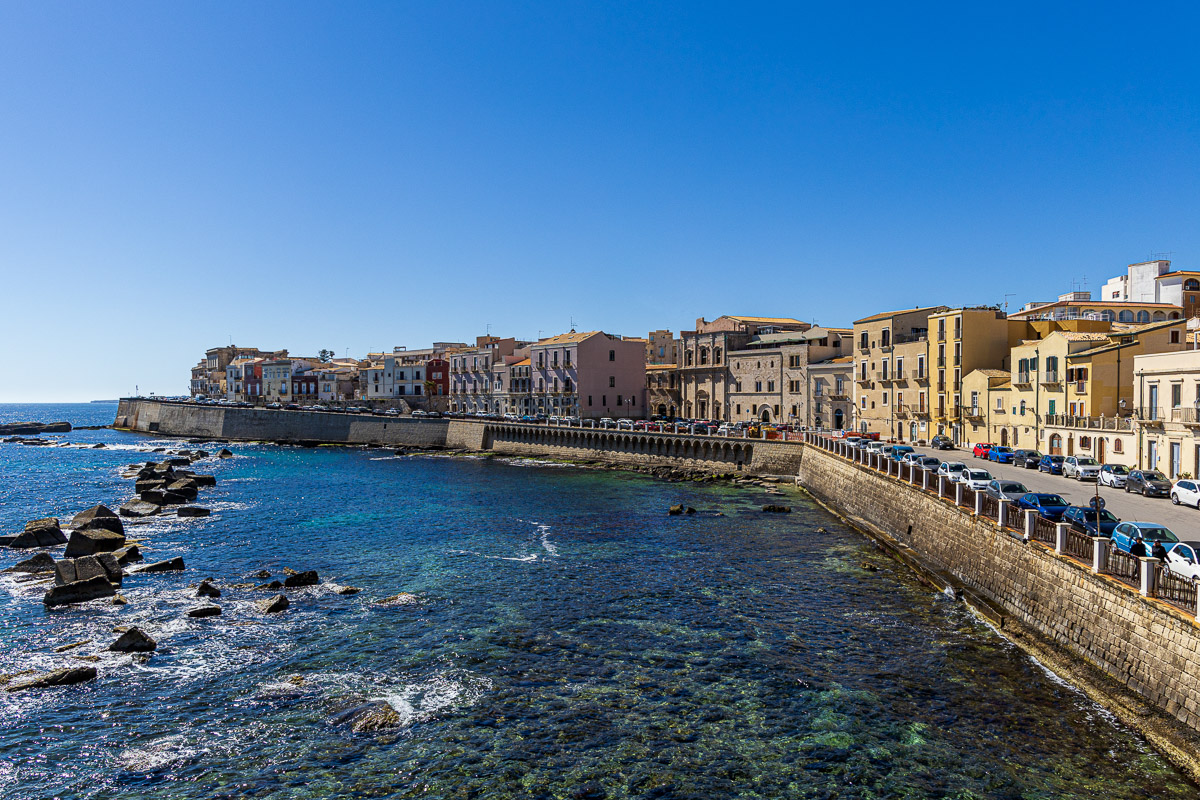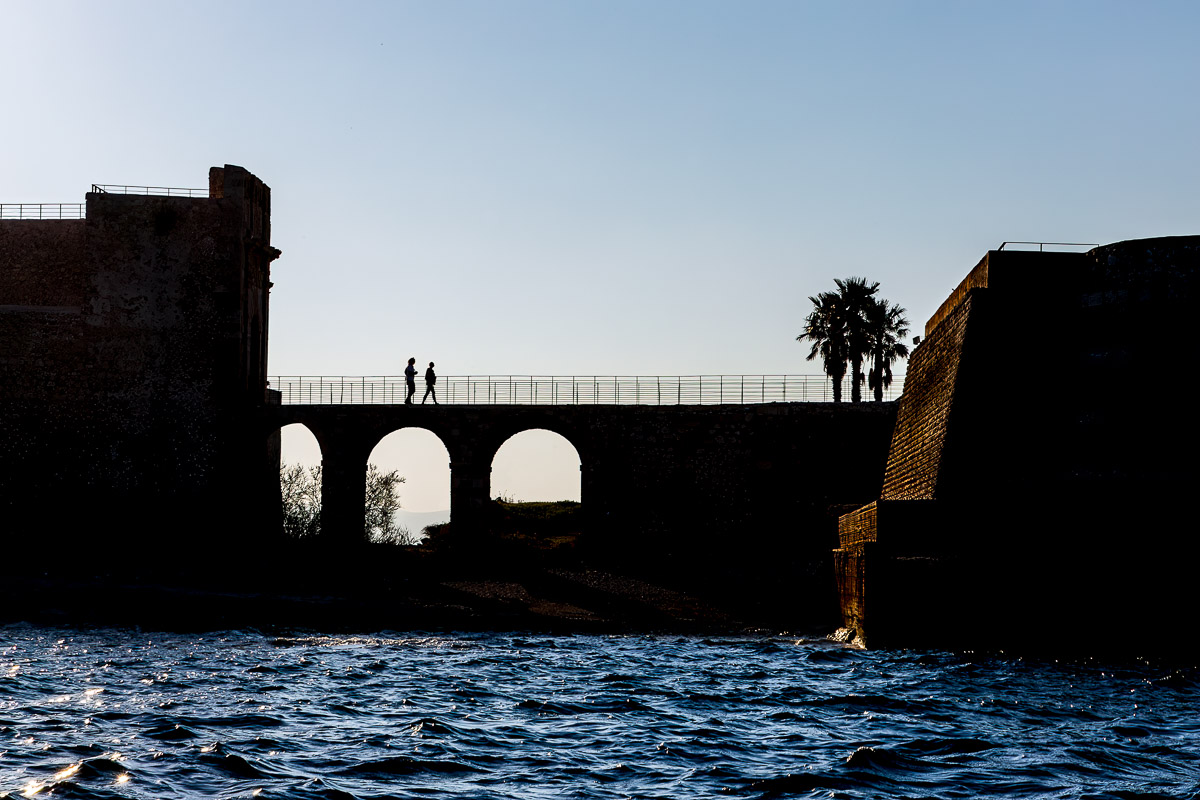Since arriving in Siracusa, we had been fairly busy with field trips to Buscemi and the Neopolis Archeological Park, but we also had ample time to do interesting things on the island of Ortigia during our three-day stay.

Although we had a nice tour of Ortigia when we first arrived in Siracusa, we decided to use our free time to explore it more thoroughly. Crossing the bridge to the island, one of the first things we encountered was a statue of Archimedes. Like most people, I knew he was a famous Greek mathematician, physicist and inventor, but I never knew he was Sicilian. You might recall that he discovered the concept of displacement after seeing the water rise when he got into his bath tub. He then ran down the street naked yelling “Eureka!” If Archimedes had taken showers instead of baths, we still might not know about displacement.
In the square by the Temple of Apollo we passed some other Americans, Mickey Mouse and My Little Kitty. Balloons sold by street vendors seem the same all over the world. Once again I enjoyed wandering through the narrow winding streets. The one by the Castello Fiorentino Restaurant was filled with tables. The restaurant wasn’t open yet but it sure didn’t look like there would be much room for the wait staff to maneuver. On the east side of the island at Forto San Giovanello we took the stairs up to a walkway with great views of the sparkling waters of the Ionian Sea. The photo above was taken there. Back at the Piazza Duomo, the large square next to the Siracusa Cathedral, we could see how the cathedral was built on the skeleton of a 5th century BCE Greek temple. They obviously knew how to reuse and recycle. After a lot of walking, we found what might have been our favorite stop, a little gelato place. We went in to do some research.
Mouse over the small photos in galleries to see captions.
Click on any one to enlarge, then use arrows to scroll through the rest of the images.
It was a warm, sunny Sunday so, in addition to looking at the sites, it was a perfect day for people watching. In the Piazza Duomo people were eating at the outdoor tables, a boy was practicing his header technique with his football, and entertainers were playing a guitar and an accordion. One man was working with a marionette of an old man who, with microphone in hand, was singing “My Way.” He sounded just like Frank Sinatra! (Well, the recording did.) This kind of entertainment is always worth a euro or two.
Then we made our way to the west side of Ortigia and walked along the Foro Vittorio Emanuele II. It was lined with trees and benches and filled with people enjoying the carnival-like atmosphere. This was a great place to view the port and part of the old city. We came across the Love Boat and I was surprised to see how much smaller it looked than the one on TV. Walking back to our hotel we encountered a group of people in a narrow street. We stepped aside as they entered a building. Out front were some people who looked like fire fighters or EMTs. I had no idea what was happening, but as I waited I thought I would practice my Italian by asking someone if I could take their picture. There were a couple of men standing there but I thought that two young women had better smiles. I said, “Posso fare la tua foto?” They replied “Si.” I took a photo, said “Grazie,” smiled and walked away My first conversation in Italian!
One afternoon the entire Road Scholar crew walked down to the harbor and climbed onto a boat for a trip around the island. We started out heading south on the west side of Ortigia and had a nice view of the city overlooking the harbor. The tree-lined Foro Vittorio Emanuele II was visible below the hillside buildings and car-lined street. The boat slowed as we pulled up along the Castello Maniace, a castle situated at the far southern point of Ortigia. As the boat stopped, our guide, Enrico, took out a bottle of Prosecco and some plastic “glasses” and poured a round for everyone. Then he passed around a box of cookies. The weather was beautiful, the sea was calm and we all enjoyed our relaxing late afternoon wine break.
Rounding the southern tip of the island and heading north, more rocks were visible close to the shore and a higher sea wall was in place to protect the city. As we swung around the north end of the island Enrico told us we would have to duck to get under a bridge that had a very low clearance. He wasn’t exaggerating; the clearance was very low. I photographed the people in front of me before I had to duck. Then, while ducking, I photographed the pilot of the boat with the bridge flying past over the top of his head. Safely on the other side, I turned to capture a view of the bridge and check to make sure none of our group had been knocked out of the boat. It was a great trip and, employing a word I haven’t used since writing a report on Magellan in fifth grade, we had circumnavigated the island.

Some might be wondering, what about the night life? Well, one evening we did go out, first to a puppet museum, the Aretuseo dei Pupi, and then to a puppet show, the Opera dei Pupi. Puppets may seem like an unusual attraction for adults, but these theaters, which started in the early eighteenth century, were very popular with the working classes. They told stories of chivalrous knights and fair maidens. They were comparable to the stories of King Arthur in England. By the last half of the twentieth century however, most of these puppet theaters had disappeared. In 2008, this art form was added to the UNESCO List of the Intangible Cultural Heritage of Humanity.
Though the puppets were supposed to be French knights, they only spoke Italian. Since none of them asked to take my picture, I didn’t understand what they were saying. These puppets are much larger than the marionette Frank Sinatra we met earlier and too heavy to be operated with strings. Rather, each one is controlled primarily with two metal rods, one that runs straight down the body and one that is connected to the right hand. A string is used for occasional movement the left hand. There was plenty of action, including vigorous sword fights. After the play the puppeteers came out to answer questions and demonstrate how they operate their characters.
On the way back to the hotel we wandered past the Fountain of Diana. It was prettier at night with the statues, bathed both in water and light, standing out against the dark sky.
<— The Really Old Days in Siracusa (Sicily Part 6) :: (Sicily Part 8) Villa Romana del Casale —>.